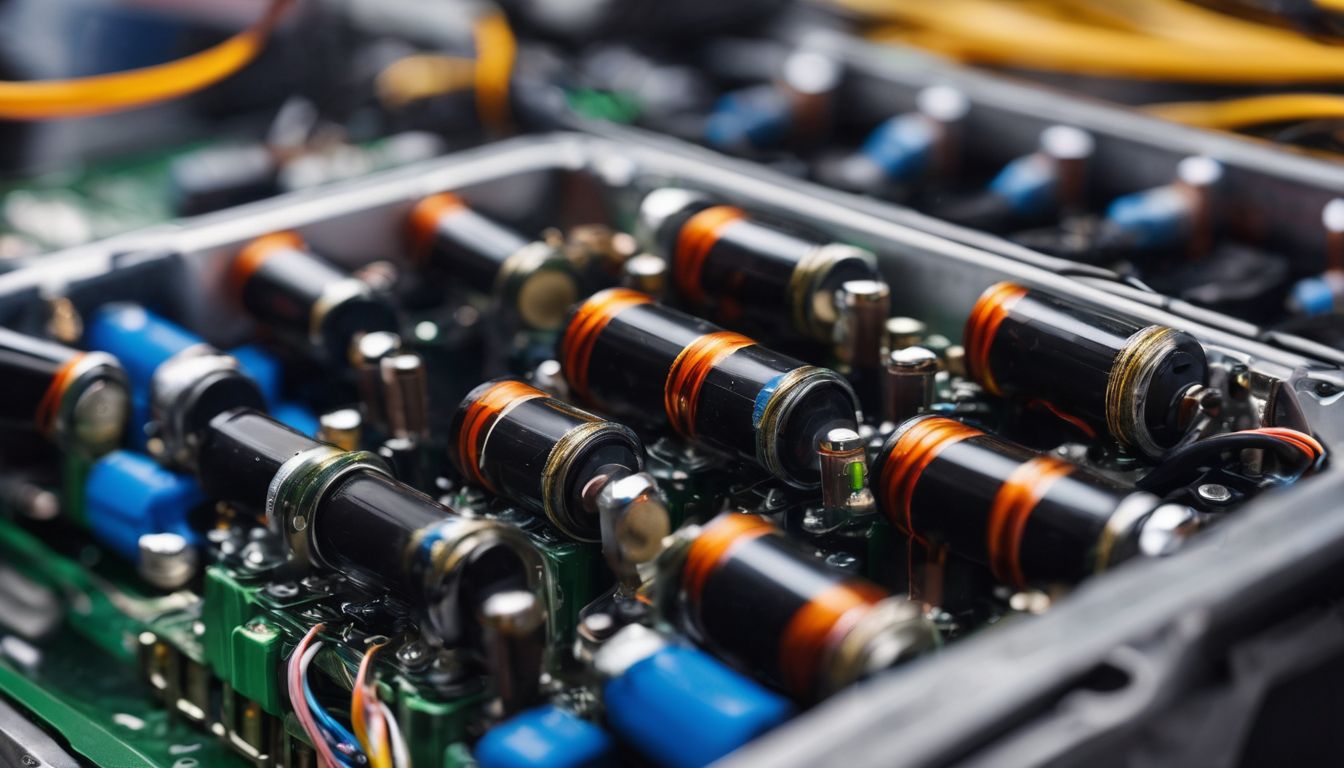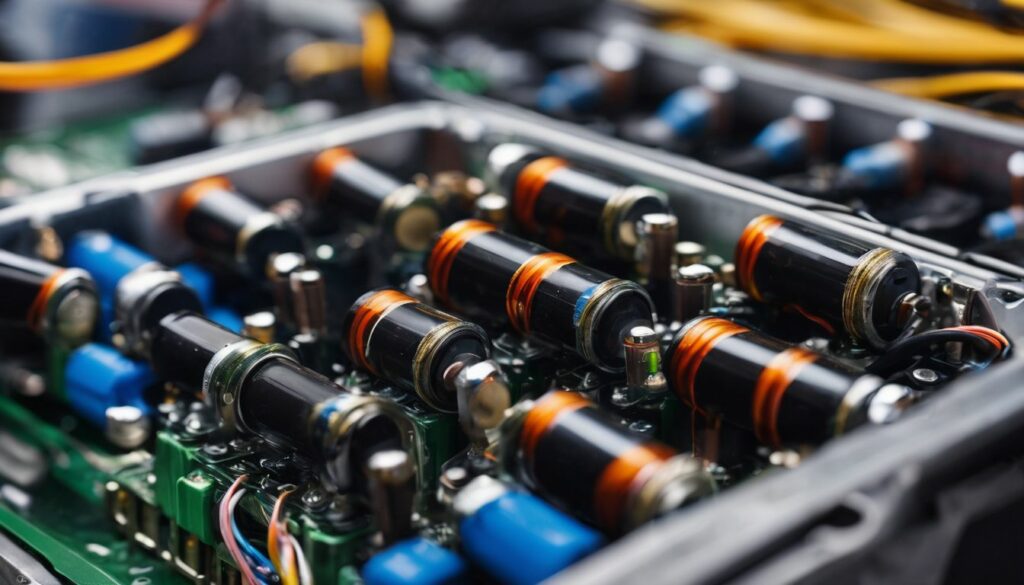 Batteries play a crucial role in powering our daily lives, yet how much do we really understand about what goes on inside them? Did you know that DC batteries convert chemical energy directly into electrical energy through a process known as ‘direct current’? This guide is your in-depth resource for discovering everything you need to know about these essential sources of power.
Batteries play a crucial role in powering our daily lives, yet how much do we really understand about what goes on inside them? Did you know that DC batteries convert chemical energy directly into electrical energy through a process known as ‘direct current’? This guide is your in-depth resource for discovering everything you need to know about these essential sources of power.
Stick around, because understanding batteries can be electrifying!
Key Takeaways
- DC batteries convert chemical energy into electrical energy through a process called direct current.
- DC batteries provide a continuous flow of electric charge in one direction and are used in devices like car batteries, cell phones, laptops, and renewable energy systems.
- Factors that affect the lifespan of DC batteries include battery type, usage, maintenance, environmental conditions, and proper care.
- DC batteries are widely used in electronics and technology devices as well as in renewable energy systems to store and distribute electricity.
- The transportation industry also relies on DC batteries to power vehicles such as electric cars, motorcycles, scooters, and power wheels.
Understanding DC Batteries
DC batteries are powered by direct current, which is a continuous flow of electric charge in one direction.
What is DC current?
DC current is a kind of power that flows in one direction. It comes from things like batteries and solar cells. This happens through a thing called a chemical reaction. Each battery has three parts: an anode, cathode, and electrolyte.
They work together to turn chemical energy into electrical energy. This kind of current is used all the time, like in car batteries!
How long do DC batteries last?
DC batteries can last for varying lengths of time, depending on factors such as the battery type, usage, and maintenance. For example, deep cycle batteries are designed to provide a continuous power supply over a longer duration and can last several years with proper care.
On the other hand, smaller DC batteries used in devices like cell phones or laptops may need to be recharged more frequently and typically have a lifespan of a few years. It’s important to note that battery lifespan can also be influenced by environmental conditions and how well you maintain and take care of your battery.
Regularly checking and maintaining the battery’s charge level, avoiding extreme temperatures, and using compatible chargers can help prolong its life.
Generating DC
DC, or direct current, is generated through a chemical reaction in sources like batteries, fuel cells, and solar cells. These devices convert chemical energy into electrical energy to produce DC voltage.
In batteries specifically, the chemical reaction occurs between the anode and cathode, with the electrolyte facilitating this process. By harnessing this chemical reaction, DC voltage is produced and can be used to power various electronic devices and systems.
Describing DC
DC stands for direct current, which is a type of electrical current that flows in one direction. Unlike AC (alternating current) which changes direction periodically, DC maintains a constant flow of electricity.
It is produced through a chemical reaction in batteries, fuel cells, and solar cells. A battery consists of three components: an anode, cathode, and electrolyte. The chemical reaction inside the battery converts chemical energy into electrical energy in the form of DC voltage.
This voltage can be used to power various devices such as cell phones, laptops, fish finders, power wheels, and scooters. DC voltage also plays a crucial role in renewable energy systems and transportation applications like electric cars.
Applications of DC Batteries
– DC batteries are widely used in electronics and technology devices like cell phones, laptops, and portable power stations. Read on to discover how they are also being applied in renewable energy systems and the transportation industry.
In electronics and technology
DC batteries play a crucial role in electronics and technology. They provide the power needed to run devices like cell phones, laptops, and portable power stations. These batteries are rechargeable, meaning they can be used over and over again without needing to be replaced.
One common type of DC battery is the lithium iron phosphate battery, which is known for its high energy density and long lifespan. In addition to powering small electronic devices, DC batteries also find applications in larger systems like fish finders, power wheels, and scooters.
Their ability to provide a steady stream of energy makes them ideal for these types of applications.
In renewable energy systems
Renewable energy systems, such as solar panels and wind turbines, often rely on DC batteries to store and distribute the generated electricity. These batteries play a crucial role in capturing and storing the energy produced by renewable sources for later use.
They help ensure a steady power supply even when the sun is not shining or the wind is not blowing. With advancements in battery technology, DC batteries have become more efficient and are being increasingly used in renewable energy systems to provide clean and sustainable power solutions.
In transportation and automotive industry
DC batteries play a crucial role in the transportation and automotive industry. They are used to power various vehicles, such as electric cars, motorcycles, scooters, and even power wheels for kids.
These batteries provide the necessary energy to propel these vehicles forward and ensure smooth operation. DC batteries also find application in hybrid vehicles where they work together with internal combustion engines to improve fuel efficiency.
With advancements in battery technology, the use of DC batteries in transportation has become more prevalent, offering a greener alternative to traditional fossil-fueled vehicles.
Conclusion
In conclusion, understanding the basics and applications of DC batteries is essential in today’s technologically driven world. From electronics to renewable energy systems and transportation, DC batteries play a crucial role.
By grasping the fundamentals of DC current and exploring its various applications, you can make informed decisions when it comes to powering your devices and embracing sustainable energy solutions.
So dive into this comprehensive guide and unlock the power of battery DC!
FAQs
1. What is a DC battery?
A DC battery, or Direct Current battery, is a kind of electrical energy storage that gives off direct current for use in various applications.
2. How does a DC battery work?
A DC Battery changes chemical energy into electrical energy. It uses this power to provide voltage and capacity for many devices.
3. What are the kinds of DC batteries?
There are many types like rechargeable batteries, motive and transportation batteries and reserve power batteries which have deep cycles for longer use.
4. How do you take care of a DC Battery?
Battery maintenance needs regular charging to keep the efficiency high. A great tool to help with this task is the Battery Management System (BMS). This system looks after the battery’s health and safety.
5. Where can we use these Batteries?
Direct current applications include everything from small electronics up to large machines needing lots of power! They’re also very handy as back-up reserves when there are power cuts or blackouts.



